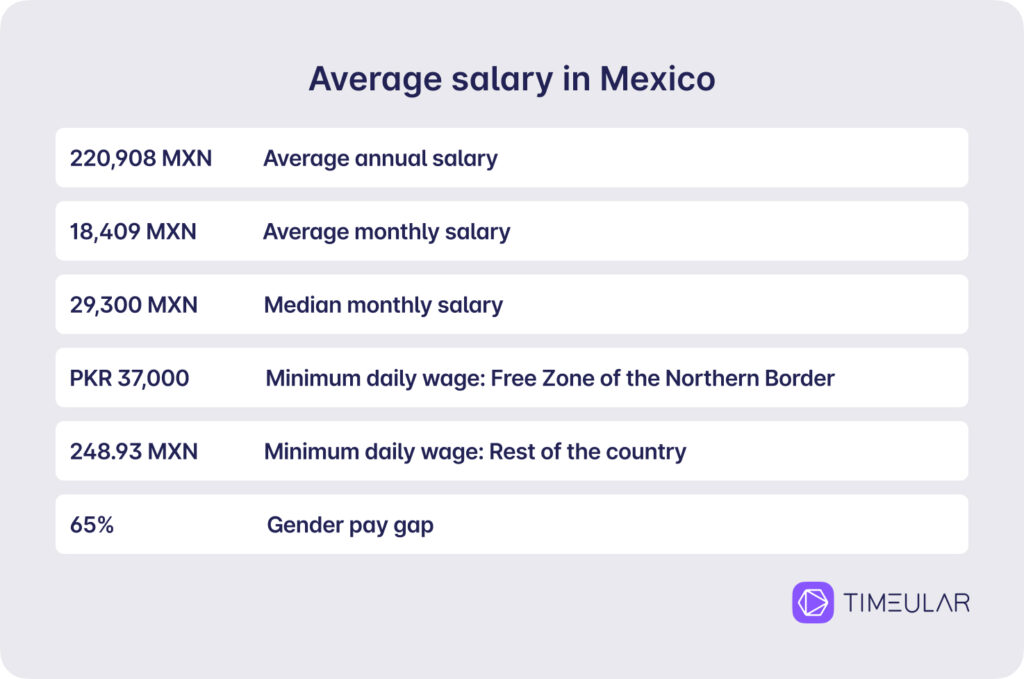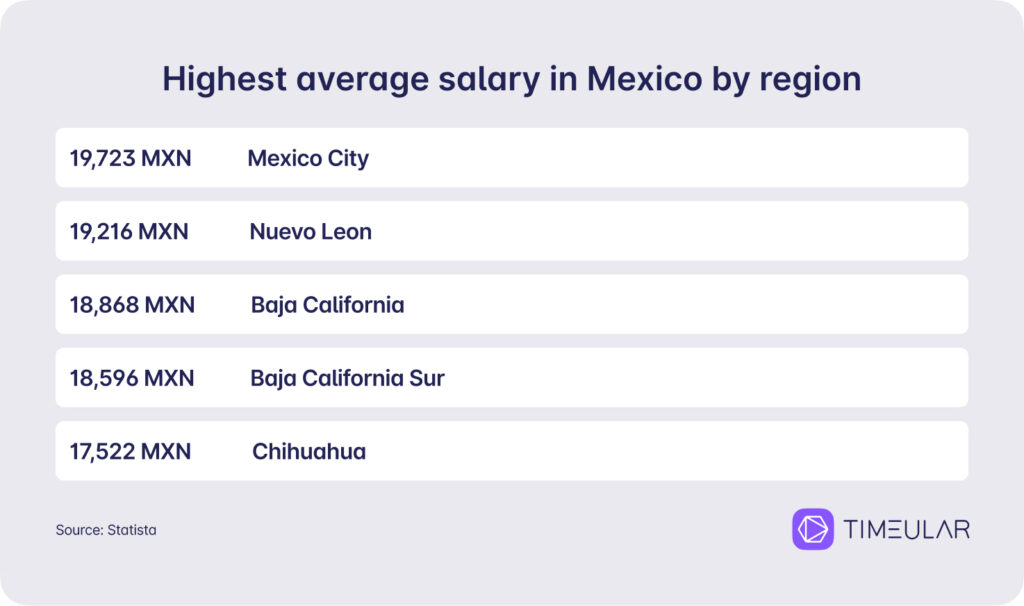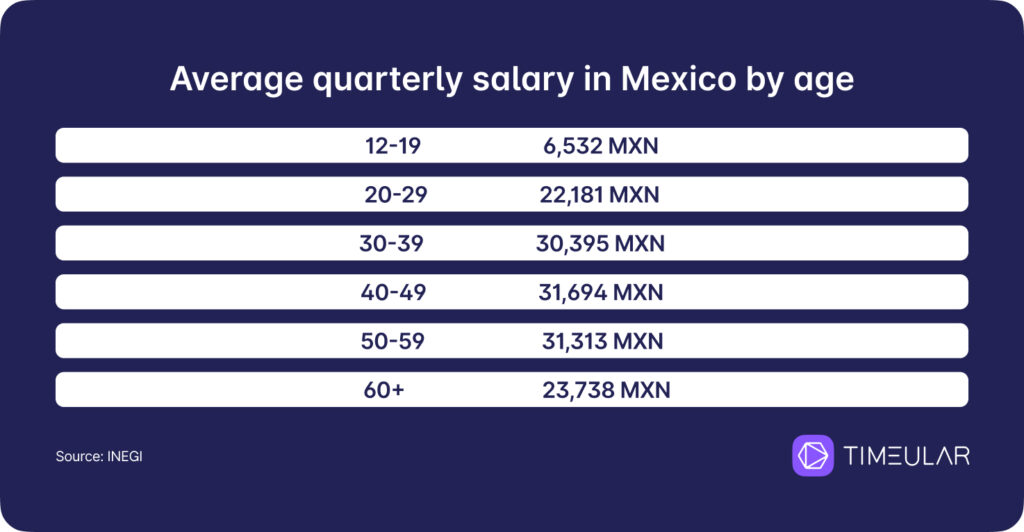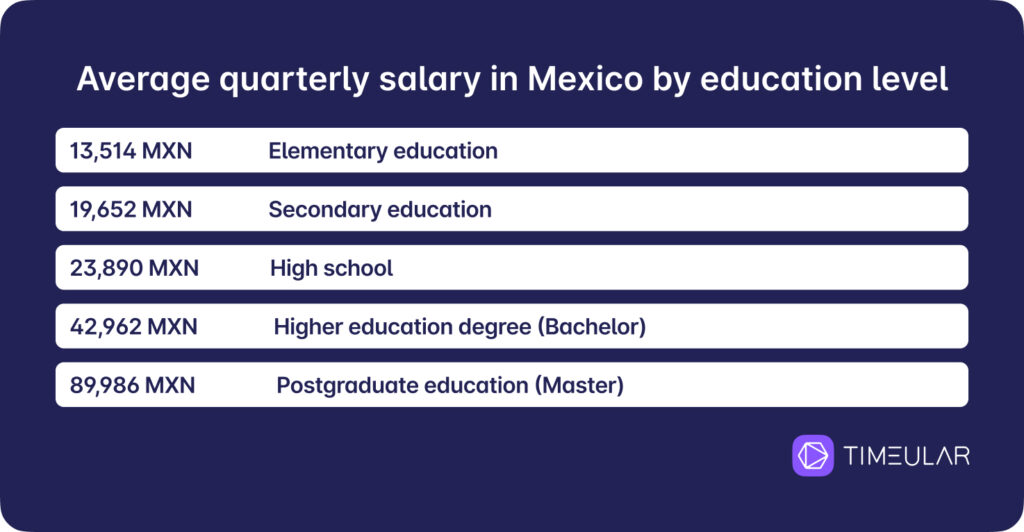Average Salary in Mexico
In 2024 the average salary in Mexico iswas220,908 MXN per year, which is around 11,715 USD (Source: OECD). This is the current state of the economy in Mexico and Central America.
The article also looks at salaries in Mexico by industry, region, age and gender to help you understand income levels across different groups.

Key takeaways
- Average annual salary in Mexico: 220,908 MXN, which is around 11,715 USD.
- Average salary in Mexico per month: The average salary in Mexico per month is approximately 18,409 MXN (220,908 MXN per year divided by 12 months), which is 1,226 USD.
- Median salary: 29,300 MXN per month, which is 1,557 USD per month.
- Minimum wage: The minimum wage varies by region, i.e.:
- Free Zone of the Northern Border: 374.89 MXN per day, which is 19.89 USD.
- Rest of the country: 248.93 MXN per day, which is 13.20 USD.
- Gender pay gap: Women earn 35% less than men.
Average salary in Mexico
In 2024, the average salary in Mexico is 220,908 MXN per year, which is around 11,715 USD. That means that on average people in Mexico earn 18,409 MXN per month, or 1,226 USD. This gives you an idea of what most people make in a year and helps to understand the income levels across the country.
Median salary
The median salary in Mexico is 29,300 MXN per month.
The median salary is the middle point, meaning that half of people earn less than this amount and half earn more. This gives a better idea of the typical income compared to the average salary, which very high or very low wages can skew. Knowing the median salary helps to understand the general income of most workers.
Source: salaryexplorer.com
Minimum wages
The minimum wage is the lowest amount of money that employers have to pay their workers by law. It ensures that employees get a basic income to cover their basic needs.
In Mexico, the minimum wage is set by the National Minimum Wage Commission (CONASAMI). This body reviews and determines the minimum wage rates to have fair wage standards across the country.
The daily minimum wage in Mexico in 2024 varies by region:
In the Free Zone of the Northern Border it’s 374.89 MXN per day. For the rest of the country it’s 248.93 MXN per day. This translates to 3,300.53 MXN per month and 39,606.36 MXN per year.
The recent increase in the daily minimum wage is an effort by CONASAMI to improve worker wages and to address regional economic differences to support better living conditions for workers.
The minimum wage has been increasing to match the cost of living and to support workers. This is an effort to improve worker wages and to address regional economic differences.
Factors impacting average salary in Mexico
- Regional differences – Salaries in Mexico vary greatly depending on the region. Major economic centers like Mexico City and Nuevo León offer higher wages compared to less developed areas, especially in the southern part of the country.
- Education – Higher levels of education generally lead to higher salaries. People with advanced degrees earn more, while those with only basic education receive lower pay. Economic factors such as inflation and productivity also play a role in determining wage levels.
- Age – Income usually increases with age and experience. Workers tend to earn more as they advance in their careers, with older, more experienced employees typically earning higher wages.
- Gender – There is a significant pay gap between men and women in Mexico. On average, women earn less than men, and this disparity persists across most sectors and age groups.
- Industry – Salaries can vary widely by industry. Jobs in certain sectors, like finance and specialized services, tend to pay more, while positions in fields like social work and waste management generally offer lower wages.
- Economic well-being – Average salaries significantly impact the economic well-being of workers in Mexico. Economic factors such as inflation, productivity, and government policies influence wage levels and purchasing power, affecting the overall economic stability of workers.
Average salary in Mexico by region

In Mexico, average salaries vary widely across different regions, reflecting the country’s economic diversity and development levels.
Mexico City, the nation’s capital and a major economic hub, has the highest average monthly salary, at 19,723 pesos. This high income level is driven by the concentration of corporate headquarters, government institutions, and a thriving service sector.
Nuevo León, home to the industrial powerhouse Monterrey, follows closely with an average monthly salary of 19,216 pesos. The state’s strong industrial base, especially in manufacturing and trade, contributes to its relatively high wages. Similarly, the northern states of Baja California (18,868 pesos), Baja California Sur (18,596 pesos), and Chihuahua (17,522 pesos) have higher-than-average salaries, reflecting their robust economies driven by manufacturing, tourism, and cross-border trade with the United States.
In contrast, regions in the southern part of Mexico generally have lower average salaries. For example, Guerrero has the lowest average monthly salary at 10,250 pesos, followed by Tlaxcala (10,844 pesos) and Veracruz (11,154 pesos).
These areas have economies that are more reliant on agriculture and less industrial development, which contributes to lower wage levels. The disparity in salaries across regions underscores the economic inequalities within the country, with the wealthier northern and central regions significantly outpacing the southern states in terms of income.
Average monthly salary in Mexico in 2023, by federal entity:
| Region | Average monthly salary | Region | Average monthly salary |
| Mexico City | 19,723 MXN | Campeche | 13,475 MXN |
| Nuevo Leon | 19,216 MXN | Tabasco | 13,399 MXN |
| Baja California | 18,868 MXN | Guanajuato | 13,237 MXN |
| Baja California Sur | 18,596 MXN | Hidalgo | 13,077 MXN |
| Chihuahua | 17,522 MXN | Michoacan | 13,007 MXN |
| San Luis Potosi | 15,685 MXN | Nayarit | 12,689 MXN |
| Queretaro | 15,556 MXN | Yacatecas | 12,632 MXN |
| Coahuila | 15,400 MXN | Mexico State | 12,612 MXN |
| Sonora | 15,104 MXN | Durango | 11,984 MXN |
| Yucatan | 14,525 MXN | Puebla | 11,602 MXN |
| Colima | 14,446 MXN | Oaxaca | 11,438 MXN |
| Sinaloa | 14,312 MXN | Morelos | 11,185 MXN |
| Quinata Roo | 14,249 MXN | Chiapas | 11,185 MXN |
| Tamaulipas | 14,178 MXN | Veracruz | 11,154 MXN |
| Aguascalientes | 14,065 MXN | Tlaxcala | 10,844 MXN |
| Jalisco | 13,887 MXN | Guerrero | 10,250 MXN |
Average salary by age
In Mexico, average salaries vary significantly by age, with income generally increasing with age until around 50, before slightly decreasing for older workers.

- For young workers aged 12-19, the average quarterly salary is 6,532 pesos. However, there is a noticeable difference between what men and women earn in this age group. Women earn 5,282 pesos, while men earn 7,544 pesos. As individuals move into their 20s, earnings increase substantially.
- The average salary for those aged 20-29 is 22,181 pesos per quarter, with women earning 18,251 pesos and men earning 25,511 pesos.
- For workers aged 30-39, the average quarterly income rises to 30,395 pesos. The gender gap persists, with women earning 23,634 pesos and men earning 36,628 pesos.
- This trend continues for those aged 40-49, who earn an average of 31,694 pesos per quarter. In this group, women earn 24,988 pesos, while men earn 37,655 pesos.
- For those in the 50-59 age group, the average salary remains relatively stable at 31,313 pesos per quarter. However, women in this age range earn 23,652 pesos, while men earn 37,947 pesos. Among workers aged 60 and older, the average quarterly income decreases to 23,738 pesos, with women earning 17,806 pesos and men earning 30,216 pesos.
Source: INEGI
| Age range | Total (MXN) | Women (MXN) | Men (MXN) |
| 12-19 | 6532 | 5282 | 7544 |
| 20-29 | 22,181 | 18,251 | 25,511 |
| 30-39 | 30,395 | 23,634 | 36,628 |
| 40-49 | 31,694 | 24,988 | 37,655 |
| 50-59 | 31,313 | 23,652 | 37,947 |
| 60+ | 23,738 | 17,806 | 30,216 |
Average salary by education level
In Mexico, the average salary varies widely based on educational attainment, with higher education typically leading to higher earnings. The average quarterly income for individuals with primary education is 13,514 pesos, while for those with postgraduate education it’s 89,986 pesos.

- For those with only elementary education, the average quarterly income is 13,514 pesos. There is a significant difference between what men and women earn at this level, with women earning 9,845 pesos and men earning 17,114 pesos.
- People with secondary education (whether completed or not) see their income rise to an average of 19,652 pesos per quarter. Again, there is a gender gap, with women earning 14,497 pesos compared to 23,973 pesos for men.
- Those who have finished or partially completed high school earn an average of 23,890 pesos quarterly. Here, men earn more than women, with men making 28,548 pesos, while women earn 18,694 pesos.
- For individuals with a higher education degree, such as a bachelor’s degree, the average quarterly income increases significantly to 42,962 pesos. Men in this group earn 49,947 pesos, while women earn 35,444 pesos.
- The highest earnings are among those with postgraduate education, such as a master’s degree. The average income for this group is 89,986 pesos per quarter, but the gender gap remains, with men earning 106,412 pesos and women earning 73,525 pesos.
Source: INEGI
| Education level | Total (MXN) | Women (MXN) | Men (MXN) |
| Elementary education | 13,514 | 9,845 | 17,114 |
| Secondary education (completed or uncompleted) | 19,652 | 14,497 | 23,973 |
| High school (completed or uncompleted) | 23,890 | 18,694 | 28,548 |
| Higher education degree (bachelor degree, completed or uncompleted) | 42,962 | 35,444 | 49,947 |
| Postgraduate education (master degree or more, completed or uncompleted) | 89,986 | 73,525 | 106,412 |
Average salary by industry
At the higher end of the salary scale the industry of pig raising stands out with the highest average monthly salary of 29,700 MXN. Followed by nonmetallic ore mining 15,019 MXN and facilities support services 14,600 MXN. Financial and insurance services also offer high pay 13,800 MXN, electric power generation and distribution 12,149 MXN and accounting, auditing and related services 13,400 MXN.
At the lower end guidance and social work services have the lowest average salary 2,151.7 MXN. Waste collection follows with 3,890 MXN. General hospital sector 4,620 MXN, basic, middle and special needs education schools 5,410 MXN, beauty salons and clinics 5,000 MXN and specialized design 5,100 MXN.
| Industry | Average salary | Industry | Average salary |
| Pig Raising | 29,700 MXN | Performing Arts Companies and Groups | 7,020 MXN |
| Nonmetallic Ore Mining | 15,019 MXN | Building Installations and Equipment | 6,933.9 MXN |
| Facilities Support Services | 14,600 MXN | Medical Doctors’ Offices | 6,450 MXN |
| Financial and Insurance Services | 13,800 MXN | Business Administration Services | 6,320 MXN |
| Accounting, Auditing, and Related Services | 13,400 MXN | Architectural, Engineering, and Related Services | 6,270 MXN |
| Electric Power Generation and Distribution | 12,149 MXN | Electronic and Precision Equipment Repair and Maintenance | 6,250 MXN |
| Residential Building Construction | 9,832 MXN | Specialized Design | 5,100 MXN |
| Psychiatric and Addiction Hospitals | 10,000 MXN | Beauty Salons and Clinics | 5,000 MXN |
| General Public Administration | 8,670 MXN | Basic, Middle, and Special Needs Education Schools | 5,410 MXN |
| Dental Offices | 8,440 MXN | General Hospitals | 4,620 MXN |
| Higher Technical Education Schools | 8,430 MXN | Waste Collection | 3,890 MXN |
| Repair and Maintenance of Automobiles and Trucks | 7,310 MXN | Guidance and Social Work Services | 2,151.7 MXN |
Highest paying jobs
- Pig Raising: 29,700 MXN
- Nonmetallic Ore Mining: 15,019 MXN
- Facilities Support Services: 14,600 MXN
- Financial and Insurance Services: 13,800 MXN
- Accounting, Auditing, and Related Services: 13,400 MXN
Lowest paying jobs
- Guidance and Social Work Services: 2,151.7 MXN
- Waste Collection: 3,890 MXN
- General Hospitals: 4,620 MXN
- Beauty Salons and Clinics: 5,000 MXN
- Specialized Design: 5,100 MXN
Gender gap in Mexico
Mexico has a long way to go to close the gender pay and participation gap. Women’s economic participation is low, 46% of women are in the labor market as of 2023, just 5% more than in 2005. At this pace it would take 119 years for women to reach men’s level of economic participation.
Mexico is the fourth lowest in women’s economic participation in Latin America (IMCO). Women in Mexico earn 35% less than men, 6,360 MXN vs.762 MXN per month. Women earn 65 MXN for every 100 MXN men earn (INEGI).
Although the gender gap in labor force participation has narrowed by 10% since 2005, there is still a big difference. Only 48% of women are in the labor force vs 81% of men (IMF). The gap is even bigger in rural areas where women’s participation is lower and they have more informal work in cities (INEGI).
The good news is that Mexico has closed 76.8% of its overall gender gap and is ranked 33rd in the 2024 Global Gender Gap Index of the World Economic Forum. This is because more women are in secondary and higher education since 2006.
But women’s economic opportunities are still behind and equality in professional and leadership positions is a long way to go (WEF).
Hallmarks of the labor market in Mexico
The Mexican economy plays a significant role in shaping salary growth trends. Economic conditions, such as inflation and GDP growth, directly impact wage levels and employment opportunities. Understanding these factors is crucial for analyzing the labor market dynamics in Mexico.
The Mexican government also influences wage conditions through policies and regulations. Government initiatives, such as minimum wage adjustments and labor reforms, can significantly affect salary growth and employment rates. These measures are essential for maintaining a balanced and fair labor market.
1. Informal employment keeps wages low and increases inequality
A big part of Mexico’s workforce is in the informal sector where jobs have no legal protection. This means lower wages and more inequality.
2. Low minimum wage and high inequality suppress overall pay
Mexico’s low minimum wage and high inequality keeps overall wages low especially in low skilled jobs.
3. Inconsistent labor law enforcement leads to uneven wages
While Mexico has labor laws to protect workers, inconsistent enforcement means that wages vary significantly, with stronger enforcement areas seeing higher pay.
4. Union influence on wages is limited by employer control
Unions have historically helped raise wages, but many are aligned with employers, which limits their effectiveness in negotiating better pay.
5. Youth and women face lower pay due to market challenges
Young workers and women often face lower wages in Mexico due to limited opportunities and wage disparities, which affects overall pay levels.
6. Migration and remittances impact local wage levels
Remittances from migrant workers can keep local wages low, while returning migrants with new skills can either demand higher pay or increase job competition, affecting wages.
7. Global trade pressures keep wages low in key industries
Mexico’s focus on low-cost labor to stay competitive in global trade, particularly in manufacturing, results in slow wage growth.
8. Skill mismatch between education and jobs lowers pay
The mismatch between workers’ skills and job requirements leads to lower wages, even for well-educated individuals, as employers do not need to offer higher pay.
Mention any interesting facts and cultural aspects about the country’s labor market which can influence the salary.
Comparison with other countries
In the global context, salaries in Mexico are relatively low compared to developed countries. As of 2024, the average salary in Mexico is around $11,715 USD per year. This is lower than in developed countries like the USA, where the average annual salary is around $65,470 USD, and Germany, where it’s around €50,250 (around $55,000 USD). Mexico’s average salary is also lower than Japan’s $30,993 USD per year.
But Mexico’s average salary is higher than other Latin American countries. For example, Mexico’s salary is way higher than in Pakistan where the average annual salary is $3,531 USD. These numbers show the broader economic gaps and different living standards across regions. Mexico’s lower average salary is due to a big informal labor sector, regional economic differences and ongoing income inequality.
FAQ
What is the average salary in Mexico?
The average salary in Mexico is 220,908 MXN per year.
What is a livable salary in Mexico?
A livable salary in Mexico is generally around the median salary of 29,300 MXN per month.
What is the average pay in Mexico in US dollars?
The average wage in Mexico is approximately 11,715 USD per year.
What is a high-paying job in Mexico?
High-paying jobs in Mexico include positions in pig raising and nonmetallic ore mining.
Sources:
- IMCO: https://imco.org.mx/en/data-and-proposals-for-equality-2024/
- IMF: https://www.elibrary.imf.org/view/journals/002/2023/357/article-A001-en.xml
- INEGI: https://www.inegi.org.mx/
- WEF: https://www3.weforum.org/docs/WEF_GGGR_2024.pdf
- Economia: https://www.economia.gob.mx/datamexico/en/profile/occupation/profesionistas-y-tecnicos?employSelector5=salaryOption
- Global Gender Gap Report 2024: https://www.weforum.org/publications/global-gender-gap-report-2024/digest/
Read more:
- Average salary in Costa Rica
- Average salary in South Korea
- Average salary in Thailand
- Average salary in US
- Average salary in Canada
- Average salary in Switzerland
- Average salary in Poland
- Average salary in Japan
- Average salary in Germany
- Average salary in Pakistan
- Average salary in Vietnam
- Average salary in Romania
- Average salary in France
- Average salary in Spain
- Average salary in Philippines
- Average salary in UK
- Average salary in Colombia
- Average salary in India
- Average salary in Australia